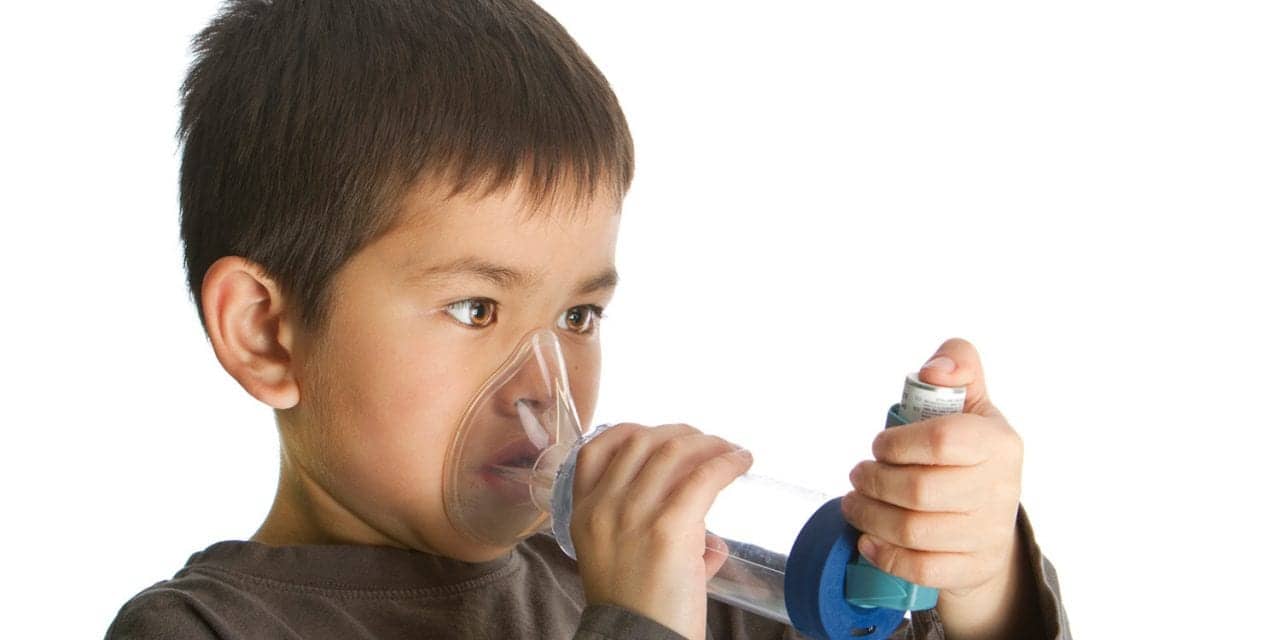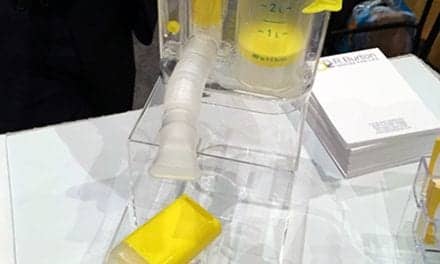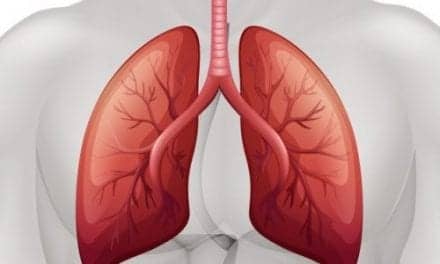Nebulizing medication is an effective maintenance therapy for chronic lung conditions like asthma or cystic fibrosis; and yet pediatric aerosol therapy adherence remains a major concern.
By Bill Pruitt, MBA, RRT, CPFT, AE-C, FAARC
Nebulizing medication for pediatric patients is an effective maintenance therapy for chronic lung conditions like asthma or cystic fibrosis; and yet medication adherence remains a major concern. This article will discuss the physiology of aerosolized medications, improving delivery of nebulized drugs, and best practices for clinicians and caregivers to maintain patients’ adherence to therapy.
The Physiology of Aerosolized Medications
Effective delivery of inhaled medicated aerosols depends on a multitude of factors. Particle size is a key factor in having the medicine be deposited the desired area of the pulmonary system. Particles are deposited by three means, inertial impaction, gravitational sedimentation, or diffusion (Brownian motion).1-2 Particle size is the major determinant in each of these. Inertial impaction affects the largest particles (those >5 µm) and depends on velocity, mass, and the location of the impact. These particles are carried forward in the inspiratory air stream and tend to travel in a straight path (inertia). When the airway turns or bifurcates, the straight line path of the particle brings it to an impact on the airway wall. This happens in the mostly oropharynx and hypopharynx. Sedimentation depends on gravity and particles in the range of 1 to 5 µm deposit as they settle out of the suspension. This happens mostly in the central airways and lower airways where bulk flow of gas is still occurring by inspiration/expiration. Particles not deposited during inertial impaction or sedimentation are mostly exhaled. Diffusion affects those particles <3 µm and in areas where there is no longer bulk gas flow. These small particles collide with other particles by Brownian motion and may land (or just stay suspended). This happens in and around the alveolar region.1-2 Hygroscopic particles (particles that can absorb humidity and water) will grow in size when in high humidity and shrink when in drier conditions. This can affect deposition by all three deposition mechanisms.
A patient’s breathing pattern will alter aerosol deposition. Inspiratory flow and the pattern of inspiration, respiratory rate, inhaled volume, inspiratory time to expiratory time ratio, and breath holding affect drug delivery. In addition, lung disease that involves bronchoconstriction, inflammation and airway narrowing (ie, by mucus) will change increase deposition by changing the angles of bifurcation, altering the speed of air moving through narrowed areas, and increasing turbulent flow.1-2
Medication aerosols are generated by many devices and produce different particle sizes and densities of aerosol that can affect deposition. The most commonly used devices include jet nebulizers (specifically- small volume nebulizers or SVN), pressurized metered dose inhalers (pMDI), soft mist inhalers (SMI), dry powder inhalers (DPI), and vibrating mesh nebulizers (VMN).3-4
In pediatric patients, medicated aerosol deposition is affected by the age of the patient, the interface with the medication delivery device, and the device itself. Drug delivery tends to increase with age.5 The interface in the youngest patients is usually a mask. Some masks incorporate a pacifier to help soothe the youngest (crying decreases drug delivery). Using “blow-by” in infants and children (where the nebulizer output is directed towards the nose) has been used in the past but has been shown to be less effective than a mask and is not recommended.6 Mask, mouthpiece, or high flow nasal cannula (HFNC) can be used to interface with older patients when using JN and VMN.5 A mask or mouthpiece interfaces with pMDI. Spacers or valved holding chambers (VHC) can be incorporated with pMDI use as well, however spacers are not as effective as VHC and are generally not recommended.2 DPI are designed with a built-in mouthpiece and are not suitable for interfacing with a mask or HFNC.
pMDI have many specific steps that need to be followed to provide the most medication to the airways. These include priming the device, shaking prior to activation, correct timing of inspiration with activation, proper placement at the mouth, proper inspiratory flow, deep breath and breath-hold, and short delay between activations. Periodic cleaning of the medication outlet is also recommended, along with another priming maneuver should the device be unused for a certain period (and many need to be primed again if the pMDI is dropped). SMI require some assembly when using a new “out-of-the-box” device, proper set-up to get the dose ready to be released, correct timing of inspiration with activation, proper placement at the mouth, proper inspiratory flow, deep breath and breath-hold. Infants and those younger than six years of age usually have a caregiver administering the inhaled medications from pMDI and/or SMI.6
SVN originally were designed to give unrestricted continuous output of medication during the full cycle of inspiration and expiration. Newer designs include breath-enhanced nebulizers (BEN) which run continuously but use vents and valves to release the aerosol during inspiration and preserve it in the device during expiration. Another new design is the breath-actuated nebulizer (BAN), which nebulizes during inspiration then stop during exhalation. Comparisons of SVN to BEN to BAN reflect more deliverable dose and higher cost for the device (respectively). All three are powered by an external flow of gas (ie, small electrically-powered compressor or hospital piped-in gases such as oxygen or air).2
VMN generate an aerosol by pumping the medication through a mesh made up of thousands of apertures.6-7 VMN are powered by battery or electricity and have been shown to be very effective and efficient in producing deliverable aerosols with little to no wasted medication.6-7 Breath-activated VMN have also been developed that help reduce wasted aerosol production during exhalation and provide more personalized drug delivery.7
Pediatric Aerosol Therapy
Improving Delivery of Nebulized Drugs
As seen above, many factors can affect delivery of aerosol medications in regards to the anatomy, different deposition mechanisms, patient-device interface, aerosol-generating device, patient skill and technique, etc. Selecting the appropriate device and interface is an important first step. The In-Check Dial (Clement Clarke International, Essex, UK) is one tool that is very useful in deciding on the drug delivery device. The In-Check has several settings that can be selected to measure the patient’s inspiratory flow in face of different resistance levels. The settings correspond to the internal resistance different devices (ie, for DPI, pMDI, etc) and helps assess that the patient can achieve a suitable inspiratory flow to get the best drug delivery. A review article by Ari published in 2021 provides a screening tool for device selection based on the child’s age, hand-breath coordination, and inspiratory flow and tools for selecting the right interface based on the type of delivery device and based on the age of the patient.6
Next, patient and/or caregiver education has been shown to be critical in self-management and in getting the drug to the airways. Education should be one-on-one and individualized. Patients should be involved in decision-making to encourage an active role in self-management and self-administration.8 Teaching the right technique and steps (especially with pMDI, DPI, and VHC use) is paramount in drug delivery. One article noted over 30 mistakes commonly made in administering medication with these devices.9 Parents and children overestimate their skills in proper administration.9 Demonstrating proper technique accompanied by verbal instruction is more effective than only verbal instruction, and technique must be checked at each visit since the patient’s grasp of proper technique fades over time. An article published in 2020 describes a new, approved teaching strategy called Teach to Goal:
“In Teach to Goal (TTG) the child is not just given instruction but first asked to explain back to the educator the key steps in the inhaler technique and why they are needed. This is then followed by the child demonstrating back (or teaching back) to the instructor the use of the inhaler. The instructor provides corrective actions and uses this iterative demonstrate back process until the child has mastered the correct inhaler technique.”9
This process needs to be repeated at least three times to reinforce proper technique that will last. This approach is also used with parents who are administering inhaler medications.
New technology is being developed that may further improve drug delivery. “Smart” nebulizers are being studied which aid delivery by controlling, calculating, and adapting to patient’s breathing patterns. These devices synchronize drug delivery with inhalation and provide feedback to the patient to reinforce proper technique. Data from the device can be stored and/or retrieved by the physician to check on technique and adherence to the plan of care.7,10 New drugs and delivery technologies are also appearing on the horizon for future nebulization, including nanoparticles, microemulsions, and lipid-based carriers.7 Surface acoustic wave nebulizers (SAWN) and other novel nebulizers are being developed for inhalation of new therapeutic agents.11 The SAWN nebulizers “produce relatively short wavelength but high frequency (10 to 100 MHz) sound waves which travel along the surface of a liquid to generate aerosols. While there are currently few in vivo human studies, the potential of SAWN has been assessed for aerosol generation of peptides and demonstrated retained monoclonal antibody and antimicrobial integrity as well as bioactivity activity and appropriate particle size for deep lung penetration”.10 A dry powder inhaler for infants and children using a hand resuscitator bag to deliver the medication(s) with positive pressure (by oral or nasal administration) is another new development that is being studied.12
Pediatric Aerosol Therapy
Best Practices to Maintain Pediatric Aerosol Therapy Adherence
Pediatric aerosol therapy adherence is a challenge and increasing adherence requires the healthcare team to address many possible ways for improvement. Access to and affordability of the medications and the delivery devices need to be considered. If unable to get to a pharmacy or afford the prescribed medication, the patient cannot adhere to a plan of care. Adherence can be improved with proper education, which provides understanding of the importance of following the plan and increases motivation. Ensuring that the education provider knows proper technique is important as well. Research has found that only 15% to 69% of clinicians across all disciplines (including physician, respiratory therapists, nurses, pharmacists) were able to use aerosol devices correctly.6 Education needs to include why it is important to take the medication(s) and how they can help (expected benefits). Possible side effects should also be discussed and preconceived ideas that are often incorrect should be addressed. What might happen if the patient does not take the medications should be covered (risks linked to nonadherence).
Striving for the simplest approaches will also help adherence. For example, if multiple medications are needed and they can be found in combination (ie, in one pMDI or one DPI) this can improve adherence. Also, scheduling medication administration for a good time of day can help, particularly in CF patients who may spend hours each day taking inhaled and oral medications and participating in secretion clearance therapies. Reducing the number of times a day medications are needed by selecting the long-acting drugs can also simplify the treatment plan (once or twice a day treatments are much more likely to be taken compared to more frequent drug administration). Provide the patient and parents with a written plan that describes what medication is taken, for what purpose, how many doses, and how often, as well as a plan to follow should symptoms flare up. Instructions should be included regarding how to know if an inhaler is empty (many patients continue using an inhaler that is empty of the medication but still “sounds” like it is delivering a dose due to the residual propellant).
With COVID-19, many providers added telemedicine approaches to care for patients. This has opened another strategy for improving adherence. Telemedicine can be accomplished by use of telephone, video links, and email. Calls and video chats can be useful in providing education, checking on adherence to the treatment plan, assessing symptoms, and general support. Objective measurements like spirometry and peak flow can be checked by using telemedicine (and many devices now connect to providers to provide timely feedback on spirometry or peak flow results as well as checking other useful details such as SpO2, HR, etc).13-14 Hundreds of cell phone and computer apps have been released to help provide feedback on technique, provide games that are designed to give constructive learning and training, reminders to take medications, help monitor symptoms and initiate alternatives in the care plan to handle flare-ups. However, many of these apps have not been validated for clinical use, so caution is warranted until the validation research has been published.14
Pediatric Aerosol Therapy
Conclusion
Pediatric aerosol therapy involves many complexities and possible roadblocks when striving to provide the best care. From selection of medications, delivery devices, and interfaces, to ensuring proper technique, avoiding side-effects, and maintaining adherence—those involved in the provision of aerosol therapy are challenged to know a great amount of detailed information, have proper skills in teaching and motivating, recognize problems and issues to correct, and have the time and resources to accomplish the goals. Respiratory therapists are intimately involved with this topic and need to continue to hone their knowledge and skills to be able to provide the best care to these patients.
RT
Bill Pruitt, MBA, RRT, CPFT, AE-C, FAARC, is a writer, lecturer, and consultant. He has over 40 years of experience in respiratory care, including more than 20 years teaching at the University of South Alabama. Now retired from teaching, he continues to write and provide guest lectures. For more information, contact [email protected].
References
- Labiris NR, Dolovich MB. Pulmonary drug delivery. Part I: physiological factors affecting therapeutic effectiveness of aerosolized medications. British journal of clinical pharmacology. 2003 Dec;56(6):588-99.
- Fink J, Ari A. Aerosol Drug Therapy (2017). In Kacmarek R, Stoller J, Heuer A. (eds.), Egan’s Fundamentals of Respiratory Care. (11th ed., 843-883). Elsevier
- Dailey PA, Shockley CM. Review of aerosol delivery in the emergency department. Annals of Translational Medicine. 2021 Apr;9(7).
- Ari A. Patient education and adherence to aerosol therapy. Respiratory care. 2015 Jun 1;60(6):941-57.
- Corcoran TE. Measurements of deposited aerosol dose in infants and small children. Annals of Translational Medicine. 2021 Apr;9(7).
- Ari A. A path to successful patient outcomes through aerosol drug delivery to children: A narrative review. Annals of Translational Medicine. 2021 Apr;9(7).
- McCarthy SD, González HE, Higgins BD. Future trends in nebulized therapies for pulmonary disease. Journal of Personalized Medicine. 2020 Jun;10(2):37.
- Bishay LC, Sawicki GS. Strategies to optimize treatment adherence in adolescent patients with cystic fibrosis. Adolescent Health, Medicine and Therapeutics. 2016;7:117.
- Morton RW, Elphick HE, Craven V, Shields MD, Kennedy L. Aerosol therapy in asthma–why we are failing our patients and how we can do better. Frontiers in pediatrics. 2020 Jun 11;8:305.
- Lange CF, Finlay WH. Liquid atomizing: nebulizing and other methods of producing aerosols. Journal of aerosol medicine. 2006 Mar 1;19(1):28-35.
- Chow MY, Chang RY, Chan HK. Inhalation delivery technology for genome-editing of respiratory diseases. Advanced Drug Delivery Reviews. 2021 Jan 1;168:217-28.
- Farkas D, Hindle M, Bonasera S, Bass K, Longest W. Development of an inline dry powder inhaler for oral or trans-nasal aerosol administration to children. Journal of Aerosol Medicine and Pulmonary Drug Delivery. 2020 Apr 1;33(2):83-98.
- Davies B, Kenia P, Nagakumar P, Gupta A. Paediatric and adolescent asthma: a narrative review of telemedicine and emerging technologies for the post‐COVID‐19 era. Clinical & Experimental Allergy. 2021 Mar;51(3):393-401.
- Ferrante G, Licari A, Marseglia GL, La Grutta S. Digital health interventions in children with asthma. Clinical & Experimental Allergy. 2021 Feb;51(2):212-20.
Pediatric Aerosol Therapy










